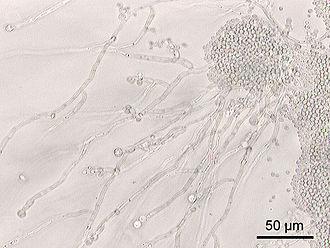Uterine microbiome
Uterine Microbiome[edit]
The uterine microbiome refers to the community of microorganisms, including bacteria, viruses, and fungi, that inhabit the uterus. This microbiome is a subject of growing interest due to its potential role in reproductive health, pregnancy outcomes, and gynecological diseases.

Composition[edit]
The uterine microbiome is composed of various microorganisms. Studies have identified the presence of bacteria such as Escherichia coli, Lactobacillus species, and Gardnerella vaginalis. Additionally, viruses like the Epstein-Barr virus and fungi such as Candida albicans have been detected.

Bacterial Community[edit]
The bacterial community in the uterus is predominantly composed of Lactobacillus species, which are also common in the vaginal microbiome. These bacteria are thought to play a protective role by maintaining a low pH environment that inhibits the growth of pathogenic organisms.

Viral and Fungal Presence[edit]
Viruses such as the Epstein-Barr virus have been identified in the uterine environment, although their role is not fully understood. Fungi, including Candida albicans, are also present and can become pathogenic under certain conditions.

Function and Importance[edit]
The uterine microbiome is believed to play a crucial role in reproductive health. It may influence fertility, implantation, and the risk of miscarriage. An imbalance in the uterine microbiome, known as dysbiosis, has been associated with conditions such as endometriosis and pelvic inflammatory disease.
Research and Studies[edit]
Research on the uterine microbiome is ongoing, with studies focusing on its composition, function, and impact on health. Advances in metagenomics and microbiome analysis techniques have facilitated a deeper understanding of this complex ecosystem.

Related Pages[edit]
References[edit]
<references group="" responsive="1"></references>
-
Microbiome analysis flowchart
-
Epstein Barr Virus virions
-
E. coli Bacteria
-
Candida albicans
-
Bar Graph of Research Papers and Articles Published for Uterine Microbiome
Ad. Transform your life with W8MD's Budget GLP-1 injections from $75


W8MD offers a medical weight loss program to lose weight in Philadelphia. Our physician-supervised medical weight loss provides:
- Weight loss injections in NYC (generic and brand names):
- Zepbound / Mounjaro, Wegovy / Ozempic, Saxenda
- Most insurances accepted or discounted self-pay rates. We will obtain insurance prior authorizations if needed.
- Generic GLP1 weight loss injections from $75 for the starting dose.
- Also offer prescription weight loss medications including Phentermine, Qsymia, Diethylpropion, Contrave etc.
NYC weight loss doctor appointmentsNYC weight loss doctor appointments
Start your NYC weight loss journey today at our NYC medical weight loss and Philadelphia medical weight loss clinics.
- Call 718-946-5500 to lose weight in NYC or for medical weight loss in Philadelphia 215-676-2334.
- Tags:NYC medical weight loss, Philadelphia lose weight Zepbound NYC, Budget GLP1 weight loss injections, Wegovy Philadelphia, Wegovy NYC, Philadelphia medical weight loss, Brookly weight loss and Wegovy NYC
|
WikiMD's Wellness Encyclopedia |
| Let Food Be Thy Medicine Medicine Thy Food - Hippocrates |
Medical Disclaimer: WikiMD is not a substitute for professional medical advice. The information on WikiMD is provided as an information resource only, may be incorrect, outdated or misleading, and is not to be used or relied on for any diagnostic or treatment purposes. Please consult your health care provider before making any healthcare decisions or for guidance about a specific medical condition. WikiMD expressly disclaims responsibility, and shall have no liability, for any damages, loss, injury, or liability whatsoever suffered as a result of your reliance on the information contained in this site. By visiting this site you agree to the foregoing terms and conditions, which may from time to time be changed or supplemented by WikiMD. If you do not agree to the foregoing terms and conditions, you should not enter or use this site. See full disclaimer.
Credits:Most images are courtesy of Wikimedia commons, and templates, categories Wikipedia, licensed under CC BY SA or similar.
Translate this page: - East Asian
中文,
日本,
한국어,
South Asian
हिन्दी,
தமிழ்,
తెలుగు,
Urdu,
ಕನ್ನಡ,
Southeast Asian
Indonesian,
Vietnamese,
Thai,
မြန်မာဘာသာ,
বাংলা
European
español,
Deutsch,
français,
Greek,
português do Brasil,
polski,
română,
русский,
Nederlands,
norsk,
svenska,
suomi,
Italian
Middle Eastern & African
عربى,
Turkish,
Persian,
Hebrew,
Afrikaans,
isiZulu,
Kiswahili,
Other
Bulgarian,
Hungarian,
Czech,
Swedish,
മലയാളം,
मराठी,
ਪੰਜਾਬੀ,
ગુજરાતી,
Portuguese,
Ukrainian




